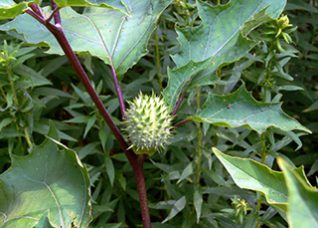
MinerAlert

MinerAlert
Datura stramonium
Solanaceae
Jamestown weed*, Mad apple, Moon flower, Sacred datura, Stramonium, Thorn Apple (Quattrocchi, 2012; White, 2003).
* Two of the plant’s common names, “Jamestown weed” and “Jimsonweed” originated from an event that occurred in Jamestown, Virginia, where a group of British soldiers was intoxicated with this plant in 1676.
Berenjena del Diablo, Chamico, Higuera del Diablo, Toloátzin, Estramonio (Quattrocchi, 2012; White, 2003; Berdonces, 2015)..

This plant is probably native to Eastern North America, but is now found, along with other species of the genus Datura, in many countries around the world (Schultes et al., 2001; Ma et al., 2015; Mabberley, 2008).
Jimsonweed is an annual plant that inhabits waste places and abandoned fields, usually near streams or “arroyos” (Kanchan and Atreya, 2016; Valverde et al., 2003).
The whole plant, especially the leaves, flowers, and seeds (Ratsch, 2005).
The leaves can be dried and rolled to make cigarettes. The leaves and seeds are sometimes dried, pulverized, and ignited in order to breathe the fumes for the treatment of asthma. The leaves and seeds are decocted in water to make a tea, but this practice is very dangerous (Ratsch, 2005; Berdonces, 2015).
Cigarettes made from this plant and other herbs have been smoked to treat bronchial asthma, but the risks of intoxication far outweigh any benefits. Despite their known toxicity, various Datura species have been employed in the traditional healing practices in many countries, including China and Tibet, for the treatment of bronchial asthma, rheumatism, inflammation, and to diminish pain (Mai et al., 2017; Ma et al., 2015; Ratsch, 2005; Berdonces, 2015).
Additionally, these plants have been used for centuries in complex religious rituals and witchcraft, due to their hallucinogenic properties, especially by various indigenous tribes in North America (Schultes et al., 2001). Unfortunately, many people are unaware of the inherent dangers related to these practices (Ratsch, 2005; Alhaj, 2006; Krenzelok, 2010; Berdonces, 2015; Kanchan and Atreya, 2016; Fu et al., 2017; Graziano et al., 2017).
Experiments undertaken in animals with various species of Datura have shown that these plants have medicinal properties for the prospective treatment of diabetes and other diseases (Krishna Murthy et al., 2004), as well as a source of atropine, an alkaloid that is used in the treatment of organophosphate insecticide toxicity (Mittal et al., 2016). Certain Datura species produce compounds known as withanolides, that have shown anti-proliferative (impede cell division), as well as anti-inflammatory activities that could be useful for the treatment of cancer and other diseases (Yang et al., 2014; Zhang et al., 2014).
Even though certain medicinal uses have been reported for Jimson weed, there are also certain serious neurological effects including hallucinations, memory loss, and anxiety, associated with its ingestion. A study found that alkaloid extracts from the leaves and fruits induced alterations of activities of critical enzymes of purinergic signaling, which suggested this could be one the mechanisms responsible for its neurological effects (Ademiluyi et al., 2016).
Two closely related genera within the Solanaceae (nightshade) family, Datura (“Jimson weed”, “Toloache”, and “Tornaloco”), as well as Brugmansia (“Trumpetflower”, “Borrachero”, “Floripondio”) may possess potential medicinal value, but should never be used for home remedies or for inebriation as “recreational drugs”, since both of these practices can prove to be lethal (Schultes et al., 2001; Ratsch, 2005; Alhaj, 2006; Graziani et al., 2017).
Safety/Precautions:
Before you decide to take any medicinal herb or herbal supplement, be sure to consult with your health care professional first. Avoid self-diagnosis and self-medication: Always be on the safe side!